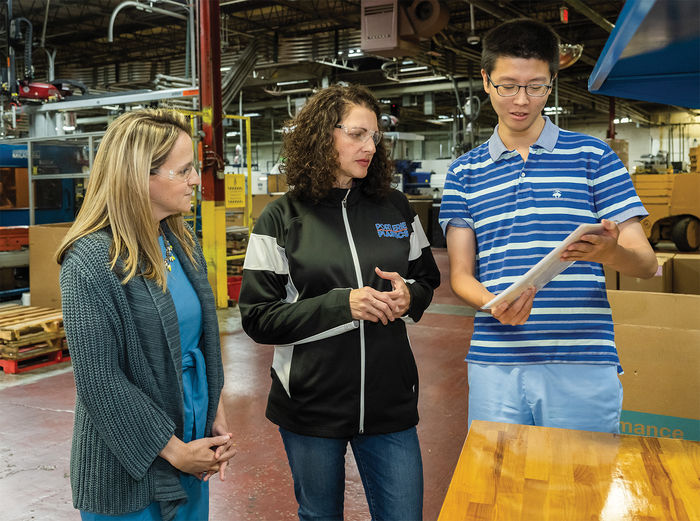Students, faculty member help company create multilingual signage for diverse workforce
Signs, signs, everywhere are signs. But what if you can’t read them? What if you’re not a native English speaker and you work in an industrial setting, for example, where signage communicates critical safety reminders? Now, imagine what it would feel like to see a sign in your language. It would likely make you feel more included, valued, and welcome in your workplace.
People in Erie who speak languages other than English may be experiencing the linguistic equivalent of seeing a friendly face in a crowd as the use of multilingual signs increases in the community, thanks in part to advocacy efforts by a Penn State Behrend faculty member.
Dr. Ashley Yochim, associate teaching professor of English, has partnered with one Erie business, Port Erie Plastics, to make communications easier for its diverse workforce by incorporating multilanguage signage at its facility. The company was inspired by Yochim’s research on the topic.
For her doctoral dissertation, Yochim analyzed the linguistic environment of Erie and learned that having public signage only in English has been a common obstacle for many immigrants and refugees transitioning to life in Erie. That landscape is evolving.
“The linguistic landscape of Erie has changed in recent years because Erie is a refugee resettlement location,” Yochim said. “The changes I have seen in the signage over the years is an interesting dynamic of that increasing population.”
Yochim spoke about her research work at Erie's Gannon University last February, which inspired students there to create multilingual signs for their campus. An employee at Port Erie Plastics in Harborcreek read a news article about the project and contacted Yochim.
“There was a need for us to better communicate with our team,” said Heather Evans, human resources manager at Port Erie Plastics. “We have a diverse organization, and we are always looking for ways to engage our team and create a strong sense of belonging.”
Excited to make an impact at a local company, Yochim assembled a student task force to work on the project.
“It was rewarding to realize that my research could affect change in the community,” Yochim said. “I welcomed the opportunity to have our Behrend students help me with it. I think sometimes our international students and those who speak other languages fluently feel their multilingualism is not appreciated in our society.”
Port Erie requested languages for directional and safety signs, and students added some of their own ideas for potential signs for the company. Behrend students translated into Arabic, traditional and simplified Chinese, Nepali, Swahili, and Vietnamese. Gannon students assisted with Spanish.
Grace Mumo, a second-year Biology major, moved to the United States three years ago from Kenya and speaks English as a second language. She translated signs into Swahili, a language she learned as a child.
“I think that this is a very noble act of Port Erie Plastics, and I was humbled to be involved,” Mumo said. “Having multiple languages on signs shows that businesses appreciate the diversity we have in the world,” she said.
Port Erie Plastics sees its diverse work force as an asset. “We believe that our diverse workforce makes us stronger, and it also makes this a fun place to work,” Evans said.
Kunyu Pan, a Behrend sophomore in Science, translated signs into traditional and simplified Chinese and said the work can help non-native English speakers obtain their goals and improve the work environment.
“I think it is important to make sure everyone can understand all signage in a factory because misunderstanding can lead to serious injuries,” Pan said.
In fact, the first set of signs Port Erie put in place features a daily safety checklist in nine languages, posted at all workstations, offering information on communicating with a supervisor, the location of fire extinguishers and emergency exits, and more.
“It is a great way to start off the workday with the right mindset and safety reminders,” Evans said.
In addition to helping Port Erie employees, Yochim said the project also benefitted the Behrend student volunteers.
“Our multilingual students bring with them such a great skill set, and this project with Port Erie Plastics was a wonderful way to demonstrate how valuable multilingualism is, and how it benefits the community,” Yochim said.
Port Erie plans to add more signs in the future after collecting feedback from its team on where the signs can be most beneficial, Evans said.
